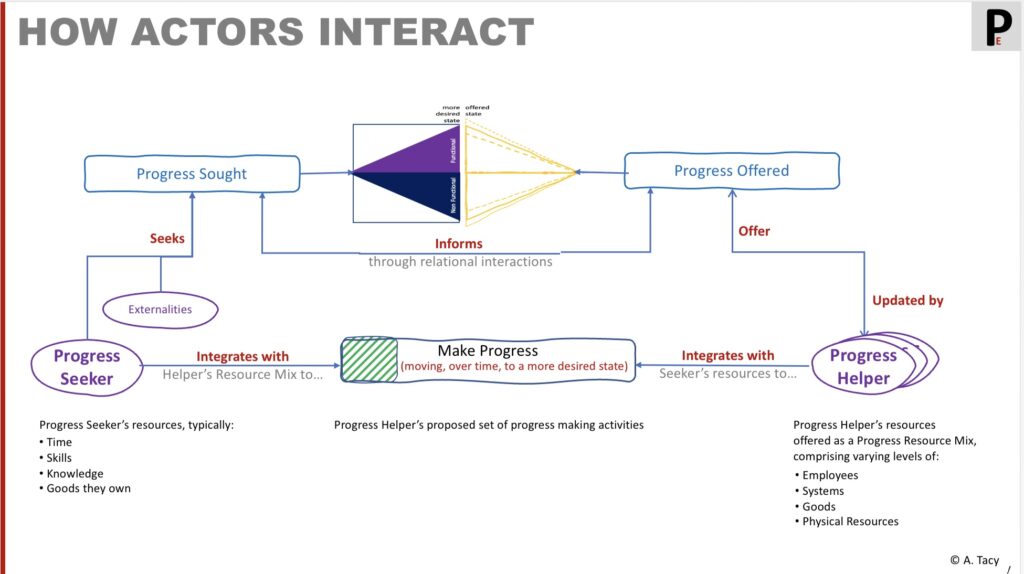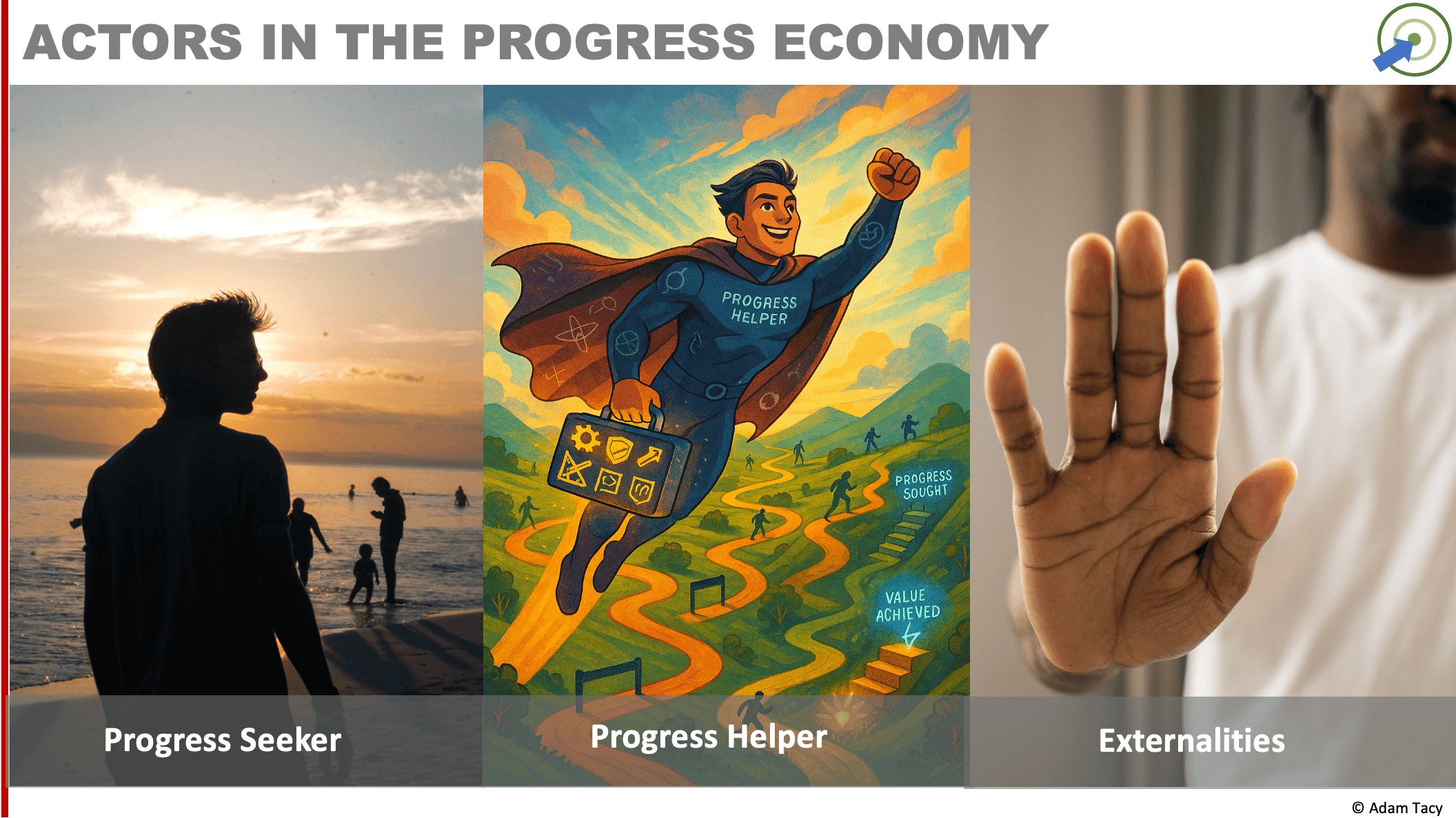What we’re thinking
There are 3 main actors in The Progress Economy:
- The Progress Seeker – striving to make progress with everything in life (progress sought)
- The Progress Helper – offering progress proposition(s): curated bundles of supplementary resources designed to help seekers reach a specific state (progress offered)
- Externalities – injecting mandated or normative elements into the progress sought (not the offered), typically to protect societal interests. Think of governments, regulators, associations, and societal norms, etc.
Critically, everyone is a Progress Seeker, including Helpers. The unequal distribution of resources required to make progress powers The Progress Economy through service exchange – often indirect and mediated via service credits (money being a dominant form).
Our actors live on a stage where value (a set of progress comparisons) is judged phenomenologically – that is, based on previous and current experience. And Seekers are the primary judges of value (sets of progress comparisons), constantly assessing whether to start, continue, or abandon a given progress journey.
Within a Helper there is the important role of progress facilitator – a one stop shop responsible for:
- understanding Seekers’ progress sought/origins
- aligning propositions to the above (through innovation and sales)
- ensuring the propositions are executed
(if you’re familiar with Agile processes, you might think of this role as a super-charged Product owner).
Let’s look deeper at these actors!
Progress SeekerS

Meet the complicated main actor of our progress economy: the Progress Seeker (often shortened to “seeker”).
Seekers are looking to make progress – moving over time to a more desirable state – in all aspects of their life.
From learning a new language, to getting nourishment, impressing someone, changing location, fixing something (a car, themselves…), building something, enjoying themselves, and much more.
For practical reasons, we often isolate specific aspects of a seeker’s progress at a time for analysis. No need to over complicate things!
Who are seekers? They can be individuals or organisations. And we can open up an organisation and see departments inside acting as seekers. Quite simply, every actor is a seeker of some progress.
Seekers are the primary judgers of value (which we see as comparisons of progress). Their judgements lead them to starting and continuing progress attempts. For example, do they feel their progress potential towards their progress sought is high enough? Or do they feel their progress reached, at any point on the journey, is in line with their expectations?
Role of the Seeker
Traditional service literature has largely approached this from a service provider–centric perspective, which differs from the Progress Economy’s Seeker-first view, though both arrive at a similar foundational insight: the Seeker is an active participant in value creation.
Bitner et al (1997) were among the first to highlight the customer’s active role in shaping service outcomes and influencing their own satisfaction and value received. They identified customers as a:
Bitner et al (1997) “Customer Contributions and Roles in Service Delivery”
- productive resource;
- contributor to quality, satisfaction and value; and
- competitor to the service organization
Bitner’s framing presents the customer as a “partial employee of the service provider”, with the provider primarily responsible for delivering the service and the customer contributing as required.
In contrast, the Progress Economy inverts this relationship: the Seeker is the primary driver of progress, and the Helper may temporarily take on the role of partial or even full employee. Still, the key insight holds: Seekers are productive resources in their own progress-making attempts.
This matters significantly when designing progress propositions. It is essential to understand which progress-making activities the Seeker can perform; and, just as importantly, which they want to perform.
Bitner et al.’s second point is particularly relevant: involving Seekers increases their likelihood of achieving their desired outcomes.
Payne et al introduce us to the concept of a series of activities in their paper on “Managing the co-creation of value”, but define them as performed by the customer.
The customer’s value creation process can be defined as a series of activities performed by the customer to achieve a particular goal.
Payne, A. F., Storbacka, K., and Frow, P. (2006) “Managing the co-creation of value”
Bettencourt, Vargo, and Lusch (2014) expanded this to perhaps be a joint approach lead by the customer:
the customer is a job (co-)executor who acts in conjunction with the firm to provide service to get a job done
Bettencourt, Vargo & Lusch (2014) “A Service lense on Value Creation”
This insight evolved in the literature into the broader concept of value co-creation, and, further, aligns closely with job-to-be-done thinking. In the Progress Economy, we interpret this simply: making progress is always a joint endeavour. Value emerges as progress is made and is evaluated through a series of progress comparisons.
Further elaborating on the role customers, are Storbacka and Lehtinen (2001) who see customers having multiple roles:
a customer (payer), a consumer, a competence provider, a controller of quality, co-producers and/or co-marketers.
Storbacka and Lehtinen (2001) “Customer Relationship Management: Creating Competitive Advantage Through Win-win Relationship Strategies”
Finally, Bitner et al’s third point reminds us that Seekers can also be competitors to a helper’s proposition – in that they sometimes chose to do the job (make the progress) themselves. Back to Bettencourt, Vargo & Lush (2014), where they note:
While the customer always participates in value creation, the customer can have a more or less active role in the service provision itself….
…thus, in matching its resources and capabilities, a company must decide where on a continuum of “enabling” to “relieving” service it will be because this impacts the service role of the customer.”
Bettencourt, Lusch, and Vargo. (2014) “A Service Lens on Value Creation”
It is from here that we pull out the concept of the progress proposition continuum – a continuum between relieving and enabling. Though our continuum positions both Seeker and propositions. The gap between a Seeker’s desired position and a proposition’s position on this continuum becomes a progress hurdle.The hurdle is higher when there is a mismatch—for example, when a Seeker wants to be fully enabled but is only offered a fully relieving proposition.
However, seekers often have an achilles heel. Progress is made through integrating resources…and seekers may not have all the necessary resources (the foundational progress hurdle of lack of resource). They might need some help…
Progress HelperS
Progress helpers are the heros in The Progress Economy.
They’ve overcome the lack of resource hurdle for a specific progress attempt – and choose to offer those hard-won new resources (skills, knowledge, physical (like strength) or abstract (like time) capabilities), to others as progress propositions,
They may have overcome that hurdle through:
- personal trial and error as a seeker
- deliberate efforts to improve progress
- training (knowledge/skill) transfer from other helper

Who are these Progress Helpers? They can be an individual, or an organisation, offering a progress proposition to help a seeker reach a state of progress offered from an assumed progress origin.
A helper may also be the facade to an ecosystem of helpers. Consider a modern retail organisation. It often acts as a facade to a payment, warehousing, and distribution/delivery helpers. Here the organisation acts as a ‘value network architect’ (Lusch et al., 2010: Service, Value Networks and Learning) or a value network’s ‘prime integrator’ (Lusch et al. (2007)). Occasionally, a seeker might co-ordinate an ecosystem of helpers themselves; or perhaps the prime integrator unbundles and offers choices (for example a variety of payment methods, or delivery partners).
If we open up an organisation we find it acts as a facade to a number of internal helpers (and seekers).
The Seeker primarily judges whether a proposition’s progress offered and progress origin align with their progress sought and origin, whether the progress potential feels achievable, and if progress reached meets expectations (all seen as value).
However, in some cases, the Helper may also judge progress potential and reached with a Seeker to see if they are a good match to their proposition – and may decline, or withdraw, use of their supplementary resources.
Finally, when progress is hindered by either a seeker or helper, we might be observing value destruction.
Dynamics of the progress economy
What drives The Progress Economy? We’re now in a position to understand this.
It’s the imbalance of resource ownership: no actor possesses all the resources needed to pursue the totality of their progress sought. This creates an opportunity for exchange of help in making progress – and we call this service exchange.
Here, “service” is (singular) – the act of helping making progress – and not to be confused with services (plural). The later being how our traditional world sees services in relation to goods.
Exchanges may be direct, I help you and you help me. More often they are indirect, typically transitive, mediated and lubricated with service credits (of which money has been a successful implementation). Service credits indicate the effort expected in exchange for providing a service; this may be a one-time or multi-time exchange.
Service credits and the notion of equitable exchange underpin business model innovation (Clauß, T, Laudien, S & Daxböck, B. (2014). Service-dominant logic and the business model concept: Toward a conceptual integration.)
The purpose of a progress helper
Understanding the dynamics of the progress economy as service exchange enables us to understand the simple purpose of a progress helper. Peter Drucker famously said:
the purpose of a business is to create a customer – as such it has two, and only two, functions: innovation and marketing.
Drucker, P. F. (1954) “The Practice of Management”
We can interpret this in the progress economy terminology.
the purpose of a Progress Helper is to attract direct or indirect equitable service exchanges in pursuit of their own progress sought – as such a progress helper has two, and only two, functions:
- marketing – continuously discovering seekers’ evolving progress sought and origins
- innovating – continuously improving progress offered and progress origin to close that gap [and minimise six progress hurdles]
For us, “customers” already exist—everyone is a Seeker and a portion of them lack the resources needed to make the progress they’re pursuing. The role of a Progress Helper, then, is to attract those Seekers—or more actionably, to attract direct or indirect equitable service exchanges. These exchanges enable the Helper to pursue their own progress sought.
For a Seeker to engage, the Helper’s proposition must be more compelling than going it alone. That means the Helper must continuously:
- Understand the Seeker’s origins, progress sought, and how those evolve over time—this is marketing.
- Evolve the proposition to help Seekers achieve better outcomes, or make existing progress easier—this is innovation.
Progress Owner
Flowing directly from the purpose of
[to add – within a progress helper we identify a need for a progress owner. Someone accountable for helping progress seekers make some specific progress. They handle the current proposition plus proposition development (innovation)
But left unchecked, Seekers may pursue progress that is harmful—to themselves, to others, or to society at large. We need an effective brake: externalities.
Externalities

Enter our final actor: Externalities. Perhaps perceived as friction in the system, they serve a deeper purpose – embedding safeguards into a seekers progress journey.
Externalities insert mandatory progress elements into progress sought – typically within the non-functional or contextual realm – such as safety, fairness, or environmental responsibility.
Who are these externalities? They are the:
- governments – enacting legislation.
- regulators – giving regulations
- associations – enforcing rules/qualifications
- society – expecting norms of behaviour
And these elements might include:
- Regulatory mandates (e.g., seatbelt laws, deposit schemes to encourage circularity)
- Licenses and qualifications (e.g., gas engineers, medical practitioners)
- Social norms (e.g., driving safely near schools)
It’s important to note: we view these elements as being inserted into the Seeker’s progress sought. They’re not just mandatory requirements – they’re things the Seeker needs help navigating. And Progress Helpers should reflect how they support these elements in their propositions.
At first glance, inserting into progress sought, rather than progress offered, might seem counterintuitive. But remember – our core philosophy is that the Seeker is the one trying to make progress.
Take this example: a Seeker wants to install a gas boiler. In the UK, any gas work must be carried out by a certified engineer. That certification requirement is inserted as a contextual element of the Seeker’s progress sought. The Seeker now has several options: they could hire a certified engineer, or even pursue certification themselves. If we treat this solely as part of the progress offered, we miss the opportunity for innovative solutions.
Yes, constraints can drive innovation—but overreach can just as easily stall progress.
editing below here
The Stage
How do all our actors interact? It’s on the stage of the progress economy. And we can see how through the simplified view of the progress economy’s 4-layer model in this diagram.

A Progress seeker together with externalities – on the left – determine specific progress they are seeking. And various progress helpers – over on the right – give offers help to make progress.
We would expect there is a relationship between progress sought and progress offered. And that is shown at the top. Progress offered needs to mostly match that sought. Otherwise it would be uninteresting to the progress seeker.
However, we anticipate that each progress helper will provide slightly different progress. Perhaps in terms of the elements and/or amounts of progress that they can assist with. And, in most cases, the supplementary package of resources provided by different helpers will differ. Perhaps one offers a relieving service with systems and employees. While another offers a more enabling proposition in the form of goods. Others are elsewhere on the progression proposal continuum.
Other helpers might be more adventurous with progress offered. Some will apply principles of disruptive innovation. Offering just enough progress to satisfy the lower end of seekers who have been left behind by incumbent helpers. And then improving till they dominated the market.
Others still may take a Blue Ocean Strategy approach. Where they may introduce, eliminate, increase and/or reduce various elements of progress sought. Looking for uncontested markets.
A seeker choses a helper through the engagement decision process. Looking for maximum progress potential and minimal progress hurdles. Once chosen, they continue their progress attempt. Intending to follow the proposed progress making activities and performing various resource integrations. That is to say, making progress.
Making progress with a proposition becomes a joint endeavour. Some combination of seeker and helper perform the progress-making activities through integrating some combination of seeker and helper resources. This leads to the powerful progress proposition continuum.
Through which value emerges as a phenomenological judgement of the amount of progress made (value co-creation and value-in-use).

Let’s progress together through discussion…